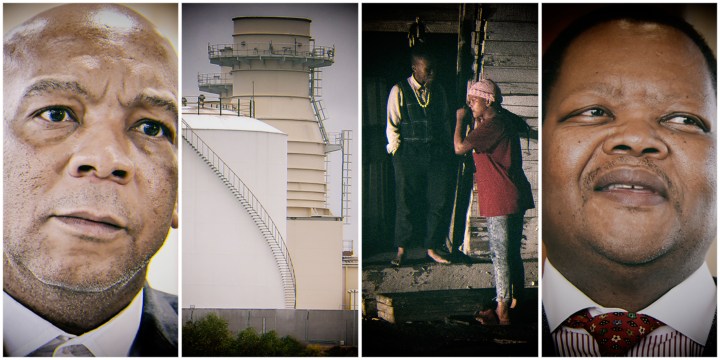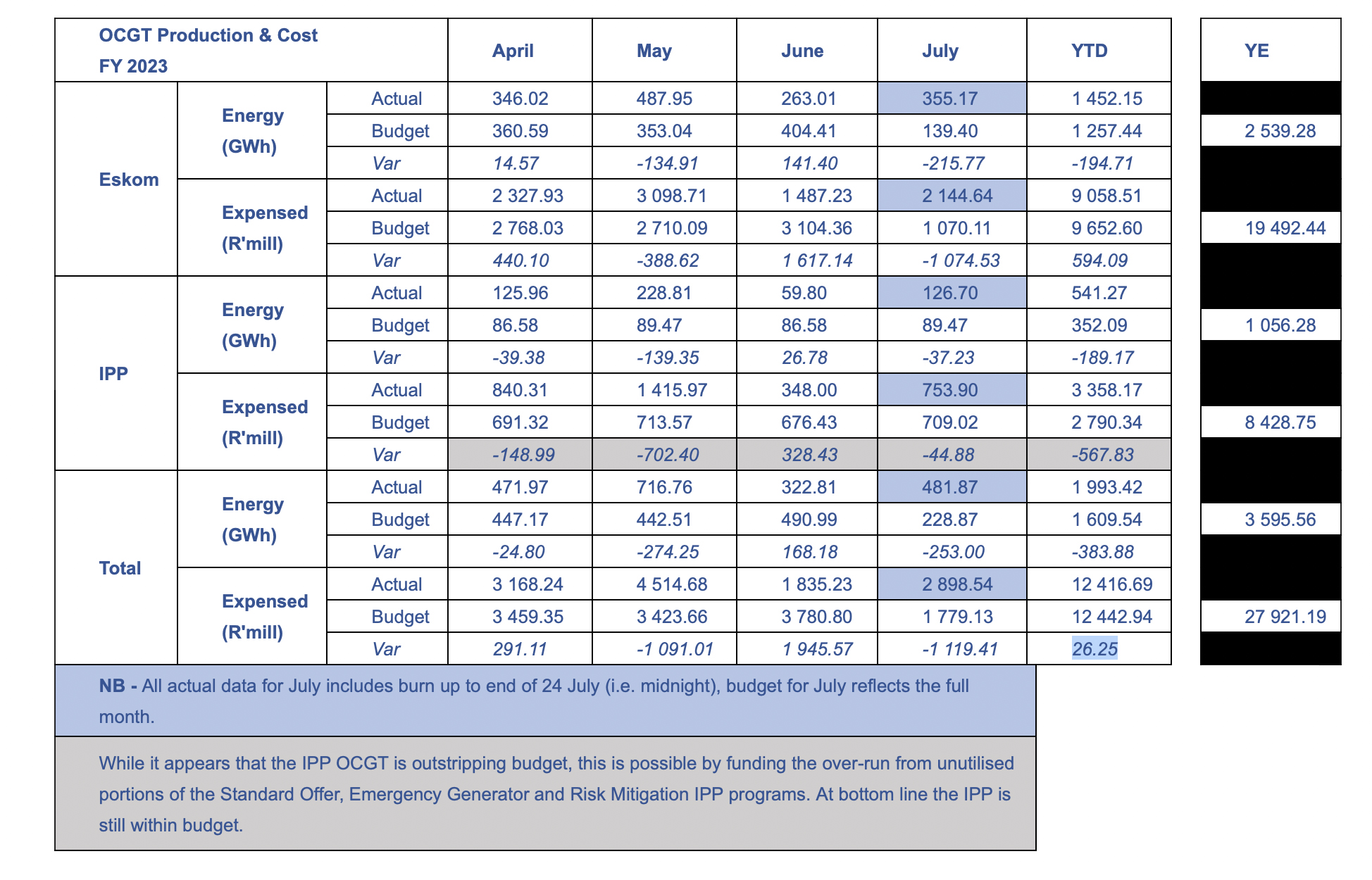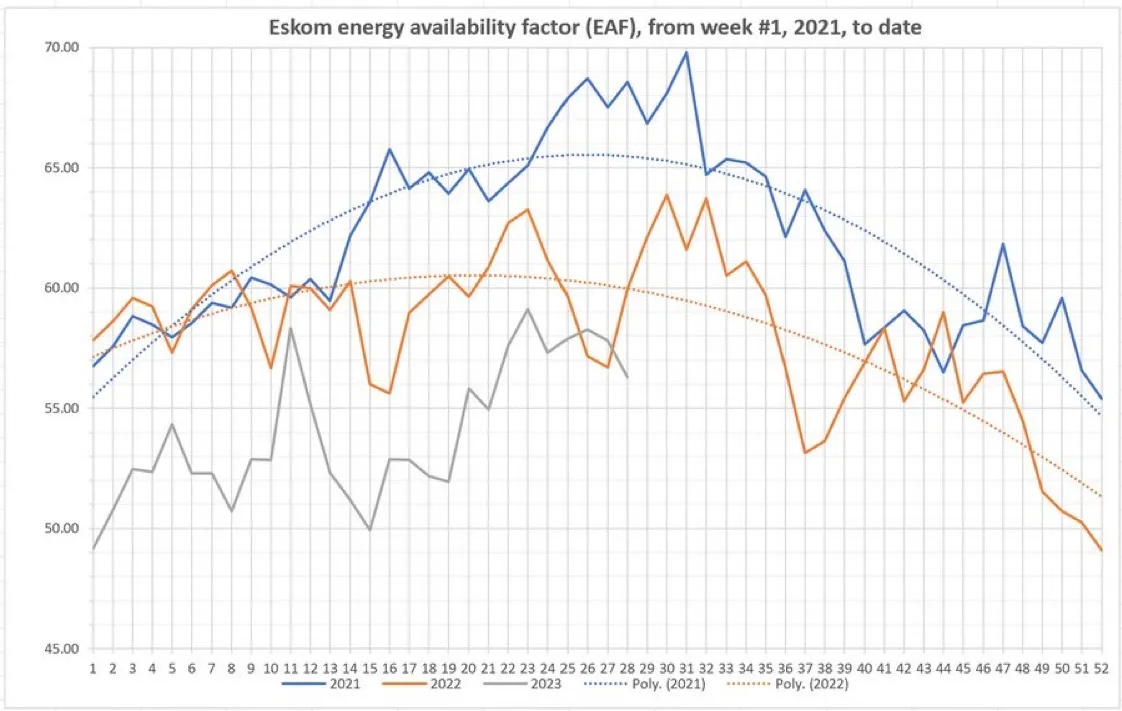POWER CRISIS
Billions blown as Eskom burns through its emergency-use diesel

Just shy of four months into its current financial year, Eskom has already blown R12.4bn on diesel to run its emergency generation fleet — nearly half its budget for the entire year.
Eskom is nearly halfway through its diesel budget of R27.9-billion, four months into the 2023/24 financial year, which ends on 31 March 2024.
To stave off higher stages of rolling blackouts between 1 April and 24 July, the power utility spent R12.4-billion of its total diesel budget on its emergency diesel-powered generation fleet to keep the lights on, Eskom confirmed to Daily Maverick this week.
To put this into perspective, it took eight months for Eskom to spend R12-billion on diesel last year, while the same amount has now been blown in less than four. This suggests that Eskom may be on track for another year of overspending on diesel to run its open-cycle gas turbines (OCGTs), which have become a vital lifeline in the face of the loss of generation capacity at Eskom’s coal-fired power stations.
In May, Electricity Minister Kgosientsho Ramokgopa predicted that a diesel budget of R30-billion would run dry before the financial year is over. But the new electricity minister’s projections seem to be at odds with Eskom, which curiously does not foresee it needing more funds from the government to procure more emergency diesel.
South Africa is enduring its worst year for power cuts by the monopoly energy utility. We are 208 days into a year that has had 207 days of load shedding. (To track the days and stages of rolling blackouts in South Africa, see The Outlier.)
The grid this week required power cuts at stages 4 and 5. The country is currently experiencing Stage 4 load shedding “until further notice”.
To fend off higher stages of power cuts, Eskom has increasingly relied on its OCGTs — which were intended only for emergencies or to run during peak demand periods. The OCGTs are used to make up for a shortfall in generation capacity when there are breakdowns and outages at Eskom’s coal-fired power stations.
Diesel is used for powering Eskom’s OCGTs at Ankerlig and Gourikwa, which have a combined energy generation capacity of 2,067MW — equivalent to two stages of rolling blackouts. There are two additional OCGT power plants, which can generate 1,005MW and are owned and operated by independent power producers (IPPs) and sell electricity to Eskom.
According to Eskom, its R27.9-billion diesel budget for the 2023/24 financial year includes R19.5-billion for Eskom’s OCGTs and R8.4-billion for the IPP OCGTs.
Rising OCGT usage and Eskom’s financial (in)stability
In its 2022 Integrated Report, Eskom’s chairperson, Mpho Makwana, noted that, in terms of Eskom’s financial stability, the use of OCGTs was “a particular cause for concern. Eskom is not in the financial position to carry the burden of extensive use of OCGTs to ensure security of supply to the country,” he said.
Last year, Eskom ran out of money to buy diesel for its OCGTs — eventually spending about R21-billion on diesel for the full 2022/23 financial year, Daily Maverick reported. This was more than double that of the 2021/22 financial year when Eskom spent R8-billion on diesel.
Winter is traditionally a nail-biting season for Eskom, when demand for power generally surpasses the power utility’s supply. This year was expected to be particularly dim, as Eskom headed into the winter season with 3,080MW of capacity less than it had the previous year. (This was because of load losses at Kusile and delays in returning one unit to service at Koeberg.)
Burning more diesel to run Eskom’s OCGTs was among the short-term interventions to ease rolling blackouts this winter that were touted by Ramokgopa in May. In an interview with Daily Maverick, Ramokgopa predicted that at the rate Eskom wanted to burn diesel to prevent higher stages of load shedding, R30-billion for diesel procurement would be sufficient for winter, but would be exhausted before the end of the financial year.
He said Eskom might have to approach the government for help again if it ran its diesel budget dry. (In 2022/23, Eskom had to approach the National Treasury for additional funds.)
Read more in Daily Maverick: Eskom’s take on avoiding blackouts this winter: ‘extremely difficult’
However, Eskom doesn’t foresee exceeding its current budget before the financial year is over.
“Eskom is not expecting that more funds will be required. Any overruns, although unlikely, will be funded from existing budgets,” it said in response to questions from Daily Maverick.
In a recent interview with Ferial Haffajee, Makwana described the utility’s use of OCGTs as “prudent”, which he said comforts the board that it will not run out of diesel.
But an analysis by Daily Maverick of data provided by Eskom has shown that its use of OCGTs has been anything but prudent for the year to date. In the 2022/23 financial year, the load factor for Eskom’s OCGTs averaged 16.6%. And before that, in the financial year 2021/22, it averaged 6.9%. In the year to date, it stands at 25.2%.
Load factor is the ratio of energy generated versus maximum generating capacity over a specific period of time.
To minimise load shedding in winter, Eskom had only planned to increase the utilisation of OCGTs to a 20% load factor for the season.
Big spender
This May, the country experienced 271 hours (adding up to 11 days and seven hours) of Stage 6 load shedding. Breakdowns at Eskom power stations reached just over 19,000MW in early May, and South Africans were enduring daily power outages of up to 10 hours.
Eskom’s data portal shows that the load factor for its two OCGTs shot up to between 19.26% and 37.45% during that time.
Eskom confirmed to Daily Maverick that May was the highest month of use of OCGTs on record. According to the power utility, it had budgeted R3.4-billion on OCGTs (Eskom and IPPs) in May, but had spent R4.5-billion.
Eskom remained within budget for the months of April and June — both of which experienced a slight reduction in load shedding because demand dipped. However, its diesel expenditure soared again in July, after icy cold fronts and frequent breakdowns forced Eskom to use more of its OCGTs to keep the lights on.

Open-cycle gas turbine production and cost for the 2022/23 financial year. (Screenshot: Supplied / Eskom)
“There have been some significant cold spells that have required more OCGTs to be run more often in July than in June. Notably, the two coldest spells also coincided with multiple generator failures requiring additional reliance on the OCGTs.
“However, cold is not the only determining factor — loss of other generating capacity coinciding with the cold weather required extensive use of the OCGTs,” Eskom told Daily Maverick.
Eskom had budgeted R1.8-billion on OCGTs (Eskom and IPPs) for July, but as of 24 July, it had already spent R2.9-billion.
In response to questions from Daily Maverick this week, Ramokgopa’s spokesperson, Kutlwano Huma, said: “It was always envisaged that Eskom will use the OCGTs, Eskom and IPPs extensively during winter, with the three Kusile units and Koeberg unit out.
“Although the OCGTs were used extensively during the winter, it is still within the budget for that period. The budget includes funding for the Risk Mitigation Programme and IPPs. The current projection reflects that there will be a surplus available in these budgets that can be utilised to fund any additional diesel requirements.”
While Eskom’s diesel spend is indeed within its forecast budget of R12.44-billion for 1 April to 31 July 2023, it had already spent R12.42-billion as of 24 July. This means the utility will need to keep its diesel purchases under R26.3-million (the difference between the forecast budget and the expenditure so far) until 31 July to remain within budget.
With seven months remaining in the current financial year, electrical engineer and energy analyst Chris Yelland said it was unlikely that Eskom would not exceed its diesel budget.
Yelland told Daily Maverick, “At the current rate of usage, and the current load factor at which the OCGTs are currently running, I expect the diesel spend to be about R36-billion.”
OCGTs are an expensive source of generation and are particularly vulnerable to fuel price fluctuations. The power utility’s diesel spend in the following months could be affected if the diesel price were to increase, Yelland explained.
Generating capacity
The only thing that might prevent Eskom from approaching the National Treasury with a begging bowl is if it improves its generation capacity. This could be a challenge if delays in returning Unit 1 at Koeberg Power Station to service continue — a touchpoint that has become a headache for Ramokgopa.
Because Unit 1 is taking so long to come back online, it’s increasingly likely that both Koeberg units will be offline at the same time, Daily Maverick reported. If both units are out at the same time, the national grid will lose 1,840MW of capacity — megawatts we can’t afford to lose, given the current performance of Eskom’s coal-fired power stations.
Read more in Daily Maverick: Further delay in life extension of Koeberg nuclear reactor worsens power outlook
Eskom’s energy availability factor (EAF) is traditionally better in winter, as the cool months bode well for the performance of Eskom’s fleet, Daily Maverick’s Ray Mahlaka reported.
EAF measures the average percentage of electricity that power stations have available to dispatch energy at any one time. A high EAF indicates that plants are maintained and operating well.

(Graph: Chris Yelland/EE Business Intelligence)
Yelland explained that Eskom’s weekly EAF for the first 28 weeks of this year was 54.08%, which is about five percentage points lower than the EAF of 59.23% for the same period last year. In a nutshell, this shows Eskom’s fleet is still underperforming compared with 2022. DM


















 Become an Insider
Become an Insider
DM. Why the noisy headline now when you had Makwana in front of you earlier this week and you avoided the awkward questions on this very subject?
But Makwana’s stated “There’s a prudent use of open-cycle gas turbines, which comforts us that we will not run out of diesel.” !
That has just proven again that behind his smug grin is nothing more than incompetent BS. Who ever appointed him!
Sadly that was DM giving the Chairman to continue the typical self-aggrandising woffle with no substance.
Great investigative journalists and very brave but like all the television and radio talk show hosts not able to recognise, shut-down or challenge utter drivel.
27 billion rand equals around 250 000 RDP homes.
GONE.
That’s around 1 million people remaining homeless.
What is most concerning is when the ANC lies to South Africa telling them all sorts of fables about how great their new minister of Electricity is while not fixing the problem, but just running the generator.
That is how the ANC buggers up every part of this country with this running the generator mentality. If you cannot do the work then you get contractors or advisors or you just dont do anything. They keep on trying to ruin every thing that works in this country by their immense stupidity and total lack of knowledge on how business and free market principles work.
Tshwane is still reeling from the quality work our dear Minister of energy did 8 years ago by entering a fraudulent meter contract. Now i see they want to roll a similar idea out at eskom to line their pocket and bring zero value to the economy.
We need to move the control of the magical country out from the their grubby criminal paws.
They can only steal and they cannot build anything positive.
Oh ja they can change names. Eastern Cape is surely the most run down province in this country but at least they have changed the names of every little town.
Well done ANC
Well done
VIVA ANC
VIVA
👍
The grid is a constraints, we have been repeatedly told. Does it not make sense to build wind / solar plant near eg Ankerlig so that Ankerlig then is used only when the renewable are not producing enough electricity. No idea whether this is viable but I would think worth exploring
Read De Ruyters book. As long as ANC leaders of the calibre of Mantashe are around nothing will happen. DR told them repeatedly to build renewable. Investors were lining up but…
.
Ideological idiocy is no longer acceptable and we must call for Mr Mantashe to go. Just kick him out unceremoniously in fact. He has been an absolute disaster for the country and the toll in unhoused and unemployed people needs to be laid at his door. He called De Ruyter a saboteur but the biggest saboteur (by far) is none but himself. Mbalula called for De Ruyter to be “smoked out”. The person who needs to be “smoked out” is himself. And finally Beke Cele said it was a pity the police could not “track down” de Ruyter. To him I say just “track out” because he is yet another completely hopeless Minsister (of no laws and disorder!).
Tim : until he saw the light on the way out the door, DR took R1m a month salary and complained Eskom is not paid a cost-reflective tariff or that SA electricity is too cheap. Well, three years ago I switched to a GWh of annual solar and my cost is half DR’s too cheap electricity.
Eskom seem to view their gas turbines as indefinite maintenance free machines. I know very little other than it’s man-made and anything man made requires maintenance. What is their plan when the OCGT’s need to be shut down for maintenance? Too much reliance on the backup system makes it the primary system. No backup for the backup. These guys can’t seem to plan and execute further than today.
Missed Opportunities: Diesel Budget vs. Abandoned PBMR Project
By financial contrast, the South African government allocated R30 billion for burning diesel this year, while just a decade ago, R8 billion went into developing our Pebble Bed Modular Reactor (PBMR). With an estimated R20 billion needed for completion, we should consider the potential gains we have lost.
The successful PBMR could have brought substantial benefits—thousands of high-paid STEM jobs, energy independence via uranium utilization, and process heat revolutionizing industries. It could have opened doors for PBMR exports, boosting our economy and global presence.
A completed PBMR would decentralize energy sources, reducing grid congestion and ensuring reliability. Discontinued as a global leader in High Temperature Gas Reactor technology, PBMR’s safety and top-quality TRISO fuel were unmatched.
While comparing budgets may appear straightforward, a comprehensive analysis would involve converting the PBMR expenditure to net present value and accounting for past and future diesel expenses. Nevertheless, it is evident that the untapped potential of the PBMR project represents a missed opportunity for South Africa’s economy and industrial landscape.
The impact of halting PBMR reverberates with unfulfilled dreams of a thriving economy and cutting-edge industries, as the patents and research legacy remind us of what could have been.
You make a good point. Besides the budgetary comparisons, there are surely still opportunities for the private sector to exploit the technology. If I recall correctly, there was significant input from Germany at the time, perhaps they have made progress with it?
Germans will not pay kickbacks to Chancers House so the project is probably dead in the water. However the Karpower ships project is another story and an “open wallet”.
PBMR is not an SA thing. The yanks, french, russians and japenese looked at it since 50y ago and concluded bad math. Exact same as coal to liquid at Sasol, except that was invented by the germans 80y ago and scrapped as a dumb idea. CTL only made sense for sanctions. PBMR lived on expensively for a while in research because the rest of world paid us to keep people occupied here instead of taking a job in Iran, Israel or North Korea.
I wonder when these OCGT will break down, because they were surely not designed to run this hard for so long. Perhaps DM can ask the real experts.
You’ve hit the nail on the head, Wilhelm. Any Emergency back-ups are designed neither for operating efficiency nor for long life. Whilst a modern 6GW steam turbo-generator working mainly as base load assurance can be expected to deliver (with less than 3% /a cost replacement parts) for 200 000 hours, surely emergency stand-by OCGT’s weren’t expected (at time of design) to operate at full load for longer than 600 hours per year, to also last 30 years?
Let’s forget about the budget overspend, and have an investigation whether the workhorses that are the OCGT’s aren’t being abused to early graves.
Less importantly, what is the all-inclusive cost of a MWh of OCGT power, generated near CT, but mostly transmitted to Gauteng, compared to the costs of our better-performing thermal coal station sets, or Koeberg’s historical costs per unit delivered to the grid?
I wonder what price is being paid for this diesel? Is it coming directly from the oil companies or is it a third party supplying it at a big mark-up? It would be interesting to see these facts and figures.
A 50 000 m3 tanker costs about R 1 billion all told, plus demurrage of about R 1 million per day. The retail margin, around R 300 million per tanker, goes somewhere, as Min. Mantashe refused Eskom a wholesale licence.
Who has the Diesel contract though? surely that is a pertinent question that should be asked as someone is making a lot of money from the diesel spend at Eskom and load shedding therefore benefits them hugely….
Busy reading De Ruyters book “Truth to Power”. It is terrifying and perfectly describes that what is happening in ESKOM aligns very closely with the manner in which this hopeless ANC Govt is destroying SA day by day. Minister “Sparky” has exposed himself; played down the industrial scale theft & corruption in Eskom and clearly wanted to look the hero which explains the rampant use of diesel and low levels of load shedding post his appointment. Stupidity has its own brutal way of exposure!
Surprise! Surprise!!!
Haffajee’s interview and this article just confirm that the chairman is nothing but a smooth talking empty suit.
Has the procurement of diesel (contracts) been investigated yet? Surely that is where the money flows….
Makes a bit of a farce of the messages from the Chairman interview earlier in the week…
What happens when the gas turbines break down from over use. The Minister of electricity seems to be the ANC minister and Eskom COO and Project director.
If the people involved in Eskom felt that it was their mission to supply their fellow South Africans with electricity then all would be well. Unfortunately that is not the case and many seem to see it rather as an ideal opportunity to rip off their fellows.
Does Eskom still procure diesel at rates that include Road Accident Fund and road levies and all the other bits and pieces? I am 101% certain (stay with me), that none of the OCGT stations are at risk of being involved in an accident on a national road. The clowns are shifting money around between departments and tenderpreneurs!
Those turbines were not designed to run every day. They will fail prematurely because of of.
An infantile, costly and ultimately self-destructive attempt to make themselves look good after the departure of André de Ruyter.
Well, it surely looks as if they tried to discredit De Ruyter in giving SAcans the idea that “they” can do beter. Hoever, now we see problems coming up. Time for me to stock up on fuel as I forecast problems from the incompetent ANC puppets draining eskom.
Why are solar and wind power being ignored? Does new minister of Electricity not understand the concept?
The big bite in the arse is coming soon!
Let’s see how the Eskom Chairman and smooth talker in the suit responds when the turbines collapse and what our Minister of Electricity will come up with.